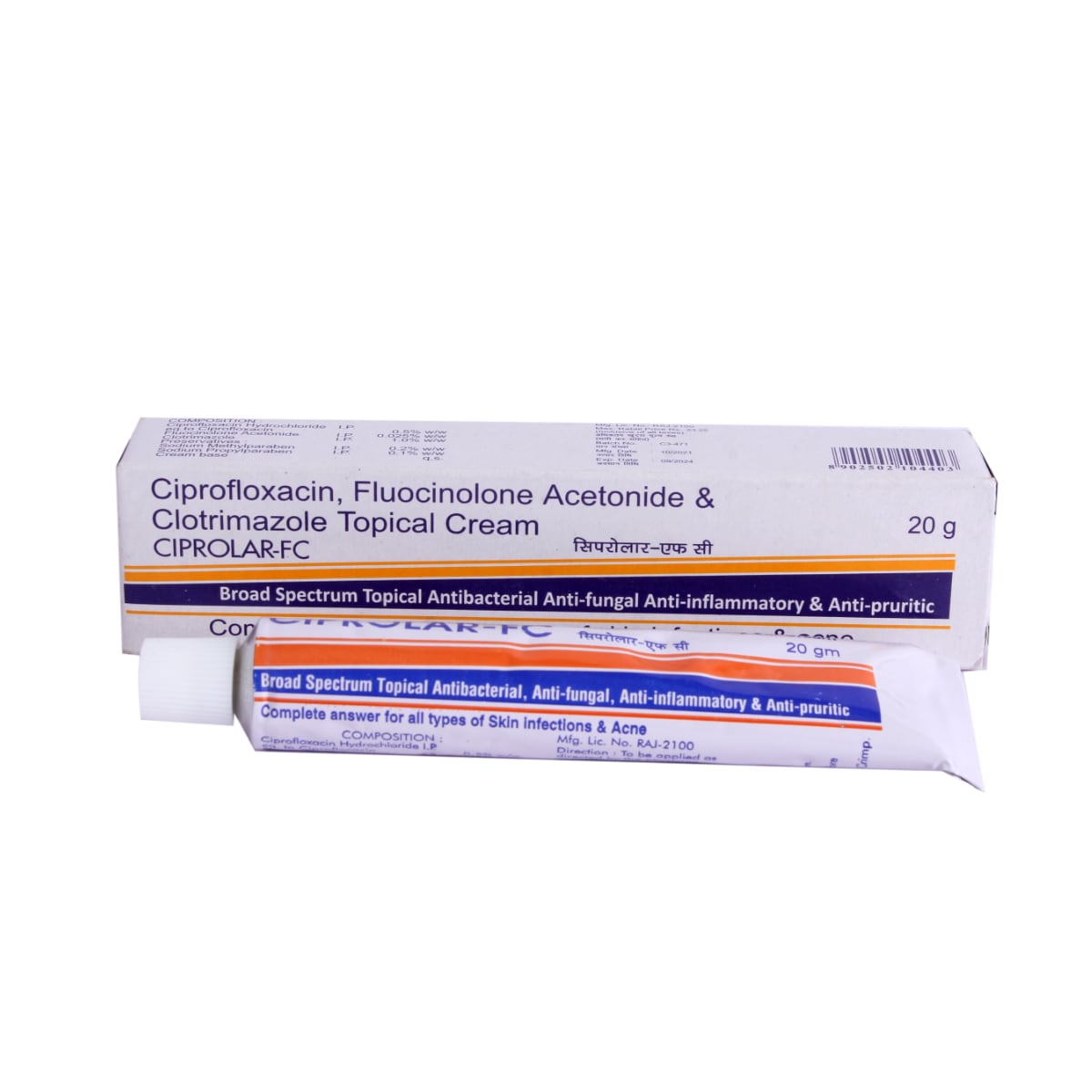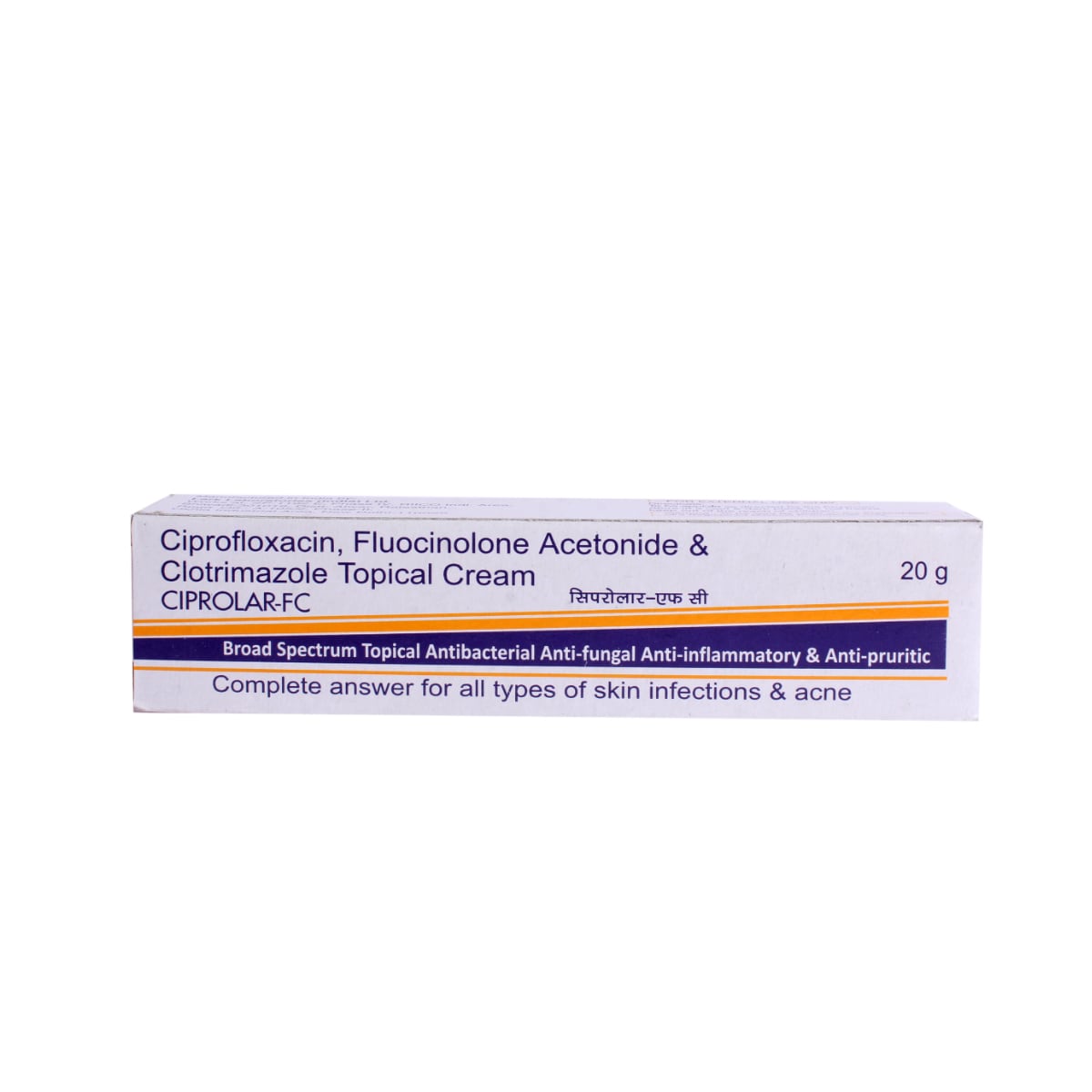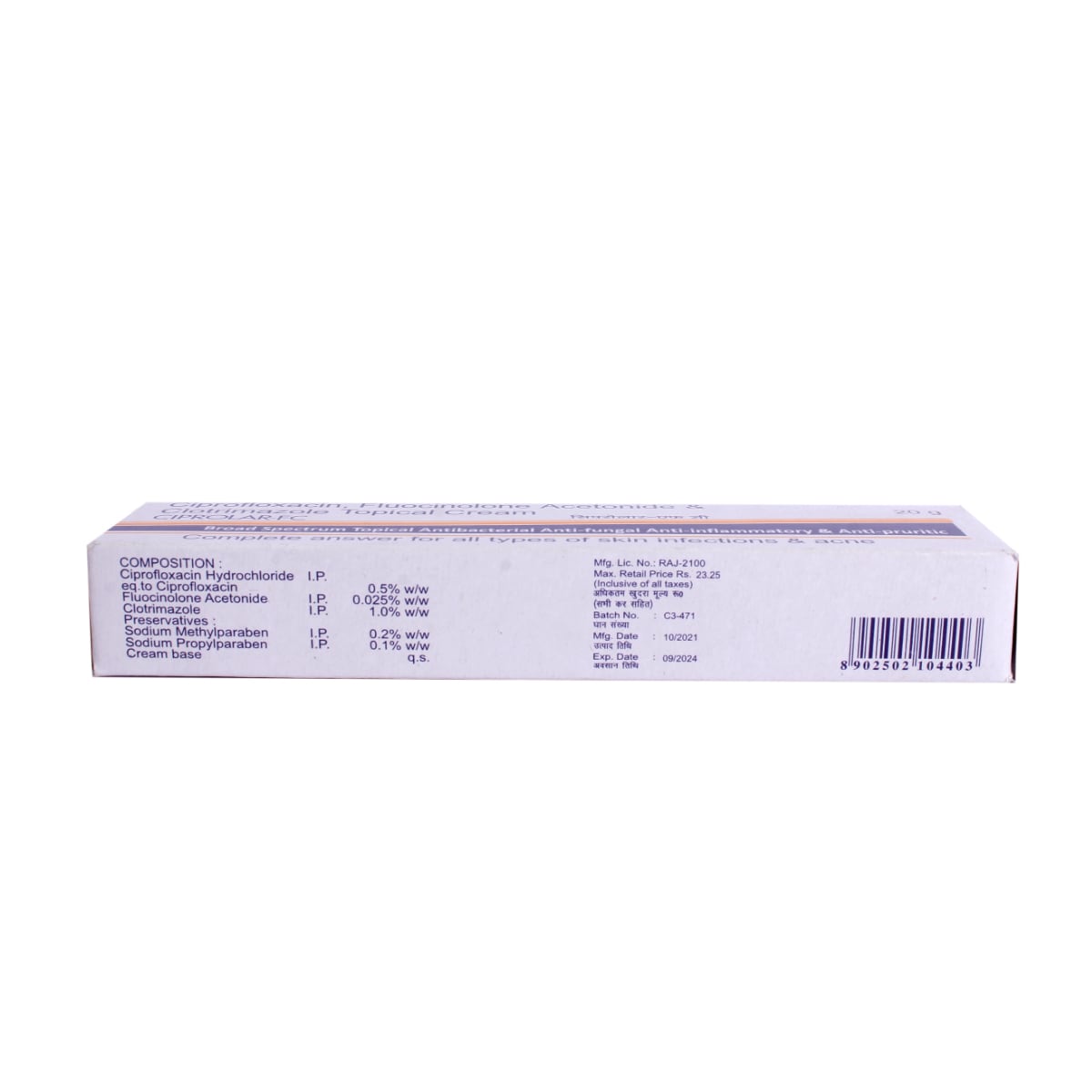Ciprolar FC Cream 20 gm






MRP ₹28.5
(Inclusive of all Taxes)
₹4.3 Cashback (15%)
Provide Delivery Location
Online payment accepted
 Prescription drug
Prescription drugWhats That
Manufacturer/Marketer :
Consume Type :
Expires on or after :
Return Policy :
About Ciprolar FC Cream
Ciprolar FC Cream belongs to a class of dermatological medication ‘Topical Anti-Infectives with steroids’ used to treat the skin's fungal and bacterial infections. Besides this, Ciprolar FC Cream also reduces swelling, itching, and redness caused due to certain skin problems. Fungal infection is a skin disease in which a fungus attacks the tissue and causes infection. Fungal infections may be contagious (spread from one person to another). A bacterial infection is a condition in which harmful bacteria grow in the body and cause infection. It can infect any part of the body and multiply very quickly.
Ciprolar FC Cream is a combination of three drugs, namely: Ciprofloxacin (antibiotic), Clotrimazole (antifungal), and Fluocinolone acetonide (corticosteroid). Ciprofloxacin belongs to the class of antibiotics that works by interfering with a bacterial enzyme involved in repairing and replicating the DNA (genetic material) of bacteria. Thereby, it kills bacteria and prevents the spread of the infection. The fungal cell membranes are essential for their survival as they prevent unwanted substances into the cells and stop the leakage of cell contents. Clotrimazole belongs to the class of antifungals that works by damaging the fungal cell membranes and kills fungi. Fluocinolone acetonide is a corticosteroid that works by acting inside skin cells and inhibits the release of certain chemical messengers in the body that cause redness, itching, and swelling. When the skin reacts to any allergens, such chemicals are released normally.
Use Ciprolar FC Cream as prescribed by your doctor. Ciprolar FC Cream is only for external use. You are advised to use Ciprolar FC Cream for as long as your doctor has prescribed it for you based on your medical condition. Some people may experience swelling, itching, redness, irritation, or burning sensation at the site of application. Most of these side effects of Ciprolar FC Cream do not require medical attention and gradually resolve over time. However, if the side effects persist or worsen, please consult your doctor.
If you are allergic to Ciprolar FC Cream or any other medicines, please tell your doctor. Ciprolar FC Cream should be used with caution in children as it may affect growth in children and teens. If you are pregnant or breastfeeding, please consult a doctor before using Ciprolar FC Cream. Avoid using Ciprolar FC Cream on scrapes, cuts, open wounds, or damaged or broken skin. Do not wrap or cover the treated area with airtight dressings unless advised by a doctor. Do not swallow Ciprolar FC Cream. In case of accidental swallowing, contact a doctor immediately. You are advised not to scratch or prick the infected areas of your skin as it may spread the infection.
Uses of Ciprolar FC Cream
Directions for Use
Key Benefits
Ciprolar FC Cream is a combination of three drugs, namely Ciprofloxacin, Clotrimazole, and Fluocinolone acetonide. Ciprofloxacin is a broad-spectrum antibiotic that acts against both aerobic (grow in the presence of oxygen) and anaerobic (increase in the absence of oxygen) gram-negative and gram-positive bacteria. It interferes with a bacterial enzyme involved in repairing and replicating bacteria's DNA (genetic material). Thus, it kills bacteria and clears the infection. Clotrimazole is an antifungal that damages the fungal cell membranes, which are essential for their survival. They prevent unwanted substances from entering into the cells and stop the leakage of cell contents and kill fungi. Fluocinolone acetonide is a corticosteroid that acts inside skin cells and inhibits the release of certain chemical messengers in the body that cause redness, itching, and swelling. When the skin reacts to any allergens, such chemicals are usually released.
Storage
- Moisturize frequently with thick, broad-spectrum moisturizers containing sunscreen.
- Use warm water for short baths, and gentle cleansers.
- Pat dry and apply moisturizer immediately.
- Use a humidifier to add moisture to the air, and choose breathable fabrics like cotton and silk.
- Wash clothes with fragrance-free detergents to minimize irritation.
- Hydrate your body: Drink enough water to prevent dehydration and headaches.
- Calm Your Mind: Deep breathing and meditation can help you relax and relieve stress.
- Rest and Recharge: Sleep for 7-8 hours to reduce headache triggers.
- Take rest: lie down in a quiet, dark environment.
- Cold or warm compresses can help reduce tension.
- Stay Upright: Maintain good posture to keep symptoms from getting worse.
- To treat headaches naturally, try acupuncture or massage therapy.
- Over-the-counter pain relievers include acetaminophen and ibuprofen.
- Prescription Assistance: Speak with your doctor about more substantial drug alternatives.
- Severe Headaches: Seek emergency medical assistance for sudden, severe headaches.
- Frequent Headaches: If you get reoccurring headaches, consult your doctor.
- Headaches with Symptoms: Seek medical attention if your headaches include fever, disorientation, or weakness.
- To keep your vocal cords lubricated and hydrated, drink lots of water.
- Suck on ice chips, popsicles, or lozenges to clear your throat and reduce hoarseness.
- Your voice cords may be soothed and healed by honey's antibacterial and anti-inflammatory properties.
- Gargle with salt water.
- Using a steam humidifier or inhaling steam might help minimize hoarseness and release mucus.
- Report the itching to your doctor immediately; they may need to change your medication or dosage.
- Use a cool, damp cloth on the itchy area to help soothe and calm the skin, reducing itching and inflammation.
- Keep your skin hydrated and healthy with gentle, fragrance-free moisturizers.
- Try not to scratch, as this can worsen the itching and irritate your skin.
- If your doctor prescribes, you can take oral medications or apply topical creams or ointments to help relieve itching.
- Track your itching symptoms and follow your doctor's guidance to adjust your treatment plan if needed. If the itching persists, consult your doctor for further advice.
- Inform your doctor about the nausea and discuss possible alternatives to the medication or adjustments to the dosage.
- Divide your daily food intake into smaller, more frequent meals to reduce nausea.
- Opt for bland, easily digestible foods like crackers, toast, plain rice, bananas, and applesauce.
- Avoid certain foods that can trigger nausea, such as fatty, greasy, spicy, and smelly foods.
- Drink plenty of fluids, such as water, clear broth, or electrolyte-rich beverages like coconut water or sports drinks.
- Use ginger (tea, ale, or candies) to help relieve nausea.
- Get adequate rest and also avoid strenuous activities that can worsen nausea.
- Talk to your doctor about taking anti-nausea medication if your nausea is severe.
- Record when your nausea occurs, what triggers it, and what provides relief to help you identify patterns and manage your symptoms more effectively.
- Consult your doctor if you experience skin redness, itching, or irritation after taking medication.
- Apply cool compresses or calamine lotion to the affected skin area to reduce irritation.
- Stay hydrated by drinking plenty of water to help alleviate symptoms and keep your skin soothing.
- Monitor your skin condition closely and promptly report any changes, worsening symptoms, or concerns to your healthcare provider.
- Consult your doctor if you experience skin redness, itching, or irritation after taking medication.
- Your doctor may adjust your treatment plan by changing your medication or providing guidance on managing your erythema symptoms.
- Your doctor may recommend or prescribe certain medications to help alleviate symptoms.
- Apply cool compresses or calamine lotion to the affected skin area to reduce redness and itching.
- Stay hydrated by drinking plenty of water to help alleviate symptoms and keep your skin hydrated.
- Monitor your skin condition closely and promptly report any changes, worsening symptoms, or concerns to your healthcare provider.
Drug Warnings
If you are allergic to Ciprolar FC Cream or any other medicines, please tell your doctor. If you have diabetes, adrenal gland or liver problems, skin reaction to any steroid medicine, or any skin infection, inform your doctor before taking Ciprolar FC Cream. Do not use Ciprolar FC Cream in more than prescribed doses, or for a prolonged time as it may cause adverse effects. Ciprolar FC Cream should be used with caution in children as it may affect growth in children and teens. If you are pregnant or a breastfeeding mother, it is advised to consult a doctor before using Ciprolar FC Cream. Avoid using Ciprolar FC Cream on scrapes, cuts, open wounds, damaged or broken skin. You recommend avoiding sunlight or tanning beds as ciprofloxacin in Ciprolar FC Cream may increase the risk of sunburn. Do not wrap or cover the treated area with airtight dressings unless advised by a doctor. Do not swallow Ciprolar FC Cream. In case of accidental swallowing, consult a doctor immediately. You are advised not to scratch or prick the infected skin areas as it may spread the infection.
Drug-Drug Interactions
Drug-Drug Interactions
Login/Sign Up
Drug-Food Interactions
Drug-Food Interactions
Login/Sign Up
Diet & Lifestyle Advise
- Regularly change your socks and wash your feet. Avoid shoes that make your feet sweaty and hot.
- In wet places such as changing rooms and gym showers, don’t walk barefoot. Wear flip-flops or sandals to prevent fungal infections.
- Do not scratch the affected area of the skin as it can spread the infection to other body parts.
- Avoid sharing towels, combs, bedsheets, shoes, or socks with others to prevent the spread of infection.
- Wash your bed sheets and towels regularly.
- Eat foods rich in quercetin (a flavonoid) such as apples, cherries, broccoli, spinach, and blueberries.
- Consuming food rich in probiotics helps in developing the immune system against allergies.
- Limit intake of food that might trigger allergies such as dairy products, soy, eggs, and nuts.
- Avoid consumption of foods with excess sugar as it may flare up inflammation.
- Include fruits, vegetables, whole grains, healthy fats, and fish in your diet.
- Avoid getting in contact with harsh soaps, detergents, and rough fabrics.
Side Effects of Ciprolar FC Cream
- Swelling
- Itching
- Redness
- Irritation
- Burning sensation at the site of application
Habit Forming
Therapeutic Class
All Substitutes & Brand Comparisons
RX
Out of StockNeocip FC Cream
Cipla Ltd
₹25
(₹1.5/ 1gm)
16% COSTLIERRX
Out of StockFrancip CF Cream
Sun Life Sciences Pvt Ltd
₹38
(₹2.28/ 1gm)
76% COSTLIERRX
Out of StockCipo-CF Cream
Sun Life Sciences Pvt Ltd
₹38
(₹2.28/ 1gm)
76% COSTLIER
Product Substitutes
Author Details
We provide you with authentic, trustworthy and relevant information
Drug-Diseases Interactions
Drug-Diseases Interactions
Login/Sign Up
FAQs
Ciprolar FC Cream contains Ciprofloxacin, Clotrimazole, and Fluocinolone acetonide. Ciprofloxacin belongs to the class of antibiotics that works by interfering with a bacterial enzyme involved in repairing and replicating the DNA (genetic material) of bacteria. Thus, kills bacteria and clears the infection. Clotrimazole is an antifungal that works by damaging the fungal cell membranes that are essential for their survival as they prevent the entry of unwanted substances into the cells and stops the leakage of cell contents. Thereby, it kills fungi. Fluocinolone acetonide is a corticosteroid that acts inside skin cells and inhibits the release of certain chemical messengers in the body that cause redness, itching, and swelling. Thereby, reduces swelling, itching, and redness caused by certain infections.
Ciprolar FC Cream may cause skin itching at the site of application as a temporary side effect. However, if the itching persists or worsens, please consult a doctor.
You are recommended to cover the treated area of skin with bandages or dressings only if advised by your doctor else it may increase the risk of side effects.
You are recommended to use Ciprolar FC Cream for as long as your doctor has prescribed it. However, if the condition persists or worsens after 2 to 4 weeks of treatment with Ciprolar FC Cream, please consult a doctor.
Yes, fungal infection is a contagious skin condition that spreads from one person to another through direct skin-to-skin contact or by contact with contaminated soil or surfaces and infected animals. Therefore, it is recommended to avoid close direct contact until the infection is clear and avoid sharing things with the infected person as it can also spread the infection.
Ciprolar FC Cream contains clotrimazole that may affect the latex in contraceptives such as diaphragms and condoms and reduce their effectiveness. Therefore, it is recommended to use other contraceptive methods for minimum 5 days after using Ciprolar FC Cream in the genital area. However, please consult a doctor if you any queries regarding this.
Ciprolar FC Cream contains ciprofloxacin that may increase the risk of sunburn. Therefore, it is advised to avoid sunlight or tanning beds, wear protective clothing and use a sunscreen while going out in the sun to prevent sunburn while using Ciprolar FC Cream. However, please consult a doctor if you experience severe redness, itching, swelling or rash after being exposed to the sun.
Drug-Drug Interactions Checker List
- BUDESONIDE+FORMOTEROL
- DULOXETINE
- ACETAMINOPHEN+HYDROCODONE
Special Advise
- Please consult a dermatologist if your skin infection persists or worsens after using Ciprolar FC Cream for 2-4 weeks.
- Ciprolar FC Cream contains Fluocinolone Acetonide a corticosteroid hence, should not be applied on broken or infected skin including acne rosacea, cold sores, chickenpox, ringworm, thrush, or athlete's foot.
Disease/Condition Glossary
Fungal infection: It is a skin disease in which a fungus attacks the tissue and causes infection. Fungal infections may be contagious (spread from one person to another). Fungal infection symptoms include scaly skin, blisters, itching, swelling, irritation, and redness. Antifungal medicines are usually used to treat fungal infections.
Bacterial infection: It is a condition in which harmful bacteria grow in the body and cause infection. It can target any part of the body and multiply very quickly. Bacteria come in three basic shapes, namely spherical, rod, or spiral-shaped. Bacteria may be gram-positive (have thick cell walls) or gram-negative (do not have cell walls). Appropriate tests are done to identify bacterial strains, and based on the results, proper medication is prescribed. Some common symptoms of bacterial infection include cough, fever, and tiredness.

Have a query?
Buy best Dermatology products by
Others
AYUR
FIXDERMA
BIODERMA
VENUSIA
CANDID
SELSUN
ABZORB
ATODERM
CIPHANDS
KETO
MINTOP
UVAVO
8X
MELALUMIN
MORR
OILATUM
REJUHAIR
SUNCROS
TETMOSOL
UNISON
UV DOUX
ATBRO SAFEXX
BETADINE
COLOPLAST
DR. MOREPEN
HAIR 4U
LA SCREEN
MEDERMA
RING GUARD
SHYN-ON
SOLSET
SUNSTOP
YUVINIE
A-DERMA
AHD
ALCONANZ
AQUAHOLD
AVARTA
AVENE
BIOLINE
BIOWRIGHT
CETRILAK
CUTICOLOR
CUTILOCK
DANDEL PLUS
DEOPHIN
DOUX
DYSIS
ENMASK 50
EXIZOL
FAIR INSTA
GETRYL
GORGEUS
GUNEERA
HAIR YUTH
HH MITE
I-GLOW
ITCH GUARD
KETOFLY
KETOMAC
KETOPZ
KETOSTAR
KZ
LIPZ
MANKIND
MEDRAYS
MELAGARD
MELNORA BLUV
MICROSTERILE
NO SCARS
OAKNET
ONABET
PARASOFT
PERCOS
PHOTON
PHOTOSTABLE
PHYSIOGEL
PROTEK
RADIBAN
RASHFREE
REGALIZ
RENOCIA
SALISIA
SEBANDRO
SEBORBAR
SESTRY
SOLASAFE
SOLECROSS
STERILLIUM
SUDERMA
SUN KROMA
SUNCLIP
SUNHEAL
SUNMATE
SUNTRIS
TAIYU
TEDIBAR
THERUPTOR
TRICOGRO
Glenmark Pharmaceuticals Ltd
Sun Pharmaceutical Industries Ltd
Klm Laboratories Pvt Ltd
Cipla Ltd
Canixa Life Sciences Pvt Ltd
Abbott India Ltd
Ajanta Pharma Ltd
Intas Pharmaceuticals Ltd
Dr Reddy's Laboratories Ltd
East West Pharma India Pvt Ltd
Alkem Laboratories Ltd
Atopic laboratories Pvt Ltd
Hegde & Hegde Pharmaceutica Llp
Brinton Pharmaceuticals Ltd
Torrent Pharmaceuticals Ltd
Amwill Healthcare Pvt Ltd
Leeford Healthcare Ltd
Palsons Derma Pvt Ltd
Oaknet Healthcare Pvt Ltd
Med Manor Organics Pvt Ltd
Micro Labs Ltd
Dermocare Laboratories Gujarat Llp
Fixderma India Pvt Ltd
Apex Laboratories Pvt Ltd
Mankind Pharma Pvt Ltd
Ipca Laboratories Ltd
Yaher Pharma
Systopic Laboratories Pvt Ltd
Menarini India Pvt Ltd
Ethinext Pharma
Nemus Pharmaceuticals Pvt Ltd
Skinocean Pharmaceuticals
Dermacia Healthcare
Inex Medicaments Pvt Ltd
Lupin Ltd
GlaxoSmithKline Pharmaceuticals Ltd
Talent India Pvt Ltd
Zydus Cadila
Kivi Labs Ltd
Zydus Healthcare Ltd
Hbc Dermiza Healthcare Pvt Ltd
Mrhm Pharma Pvt Ltd
Regaliz Medicare Ltd
Sol Derma Pharmaceuticals Pvt Ltd
Newtrimed Healthcare Pvt Ltd
Wallace Pharmaceuticals Pvt Ltd
Eskon Pharma
Glowderma Lab Pvt Ltd
La Pristine Bioceuticals Pvt Ltd
Mohrish Pharmaceuticals Pvt Ltd
Percos India Pvt Ltd
Rockmed Pharma Pvt Ltd
Macleods Pharmaceuticals Ltd
Praise Pharma
Ethicare Remedies Pvt Ltd
Kaizen Drugs Pvt Ltd
Aurel Biolife
Rely On Pharmaceuticals
Wockhardt Ltd
Galcare Pharmaceuticals Pvt Ltd
Elder Pharmaceuticals Ltd
Indiabulls Pharmaceuticals Pvt Ltd
La Med Healthcare Pvt Ltd
Biocute Life Care
Yap Bioceuticals
Yash Pharma Laboratories Pvt Ltd
Zee Laboratories Ltd
Apple Therapeutics Pvt Ltd
Adonis Laboratories Pvt Ltd
Albatross Healthcare Pvt Ltd
Galderma India Pvt Ltd
Prism Life Sciences Ltd
FDC Ltd
Alniche Life Sciences Pvt Ltd
Salve Pharmaceuticals Pvt Ltd
West Coast Pharmaceuticals Pvt Ltd
Dermarex HealthCare India Pvt Ltd
Arka Vital Science Pvt Ltd
Dermajoint India
Gary Pharmaceuticals Pvt Ltd
Grace Derma Healthcare Pvt Ltd
Karlin Pharmaceuticals & Exports Pvt Ltd
Skinska Pharmaceutica Pvt Ltd
Uniza Healthcare Llp
Alembic Pharmaceuticals Ltd
Cadila Healthcare Ltd
Cadila Pharmaceuticals Ltd
Cosmofix Technovation Pvt Ltd
Human Pharmaceuticals
Indolands Pharma Pvt Ltd
Lyra Laboratories Pvt Ltd
Akumentis Healthcare Ltd
Entod Pharmaceuticals Ltd
Iceberg Health Care Pvt Ltd
Jenburkt Pharmaceuticals Ltd
P and P Dermaceuticals Pvt Ltd
Dabur India Ltd
Indchemie Health Specialities Pvt Ltd
Olcare Laboratories Pvt Ltd
Unison Pharmaceuticals Pvt Ltd
BODY CREAM
Body Lotion
Face Cream
Shampoo
Sun Screen
Face Gel
Soap
Face Wash
HAIR SOLUTION
Face Serum
BODY GEL
Hair Lotion
Hair Serum
Dusting Powder
ANTISEPTIC
FACE CLEANSER
Face Lotion
Body Wash
Body Spray
Eye Cream
FUNGAL INFECTION
Foot Cream
Conditioner
Eye Gel
Cleanser
Hair Cream
Hair Oil
Face Mask
Hair Gel
Sanitizer
Hair Spray
Moisturiser
Skin Ointment
Lip Balm
Capsule
Eye Serum
Intimate Wash
Specialty Supplements
Hand Cream
Facial Spray
SPECIALITY SUPPLEMENT
Face Toner
MEDICATED SHAMPOO
Tablet
Talcum Powder
BABY SUNSCREEN
Body Butter
Body Scrub
DIAPER RASH CREAM
EYE SOLUTION
FACIAL WIPE
Gargle
Hand Wash
Intimate Spray
Lip Serum
Lubricant Gel
MEDICATED CREAM
Nail Polish
VITAMIN D
Alcohol
Safe if prescribed
Interaction of Ciprolar FC Cream with alcohol is unknown. Please consult a doctor before consuming alcohol while using Ciprolar FC Cream.
Pregnancy
Consult your doctor
Ciprolar FC Cream is given to pregnant women only if the doctor thinks benefits outweigh risks. Please consult a doctor if you are pregnant or planning for pregnancy.
Breast Feeding
Consult your doctor
It is unknown whether Ciprolar FC Cream is excreted in human milk. Therefore, Ciprolar FC Cream is given to breastfeeding mothers only if the doctor thinks benefits are greater than risks. Please consult a doctor if you are breastfeeding.
Driving
Safe if prescribed
Ciprolar FC Cream usually does not affect your ability to drive or operate machinery.
Liver
Consult your doctor
If you have any concerns regarding the use of Ciprolar FC Cream in patients with Liver problems, please consult a doctor.
Kidney
Consult your doctor
If you have any concerns regarding the use of Ciprolar FC Cream in patients with Kidney problems, please consult a doctor.
Children
Safe if prescribed
Ciprolar FC Cream should be used with caution in children as it may affect growth in children and teens.






